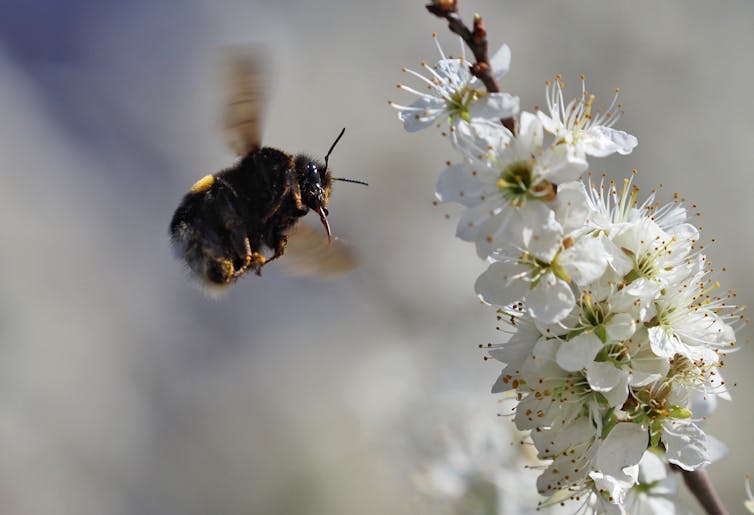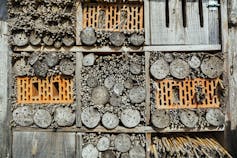Bees can learn, remember, think and make decisions – here’s a look at how they navigate the world

Soeren Stache/picture alliance via Getty Images
By Stephen Buchmann, University of Arizona
As trees and flowers blossom in spring, bees emerge from their winter nests and burrows. For many species it’s time to mate, and some will start new solitary nests or colonies.
Bees and other pollinators are essential to human society. They provide about one-third of the food we eat, a service with a global value estimated at up to $US577 billion annually.
But bees are interesting in many other ways that are less widely known. In my new book, “What a Bee Knows: Exploring the Thoughts, Memories, and Personalities of Bees,” I draw on my experience studying bees for almost 50 years to explore how these creatures perceive the world and their amazing abilities to navigate, learn, communicate and remember. Here’s some of what I’ve learned.
It’s not all about hives and honey
Because people are widely familiar with honeybees, many assume that all bees are social and live in hives or colonies with a queen. In fact, only about 10% of bees are social, and most types don’t make honey.
Most bees lead solitary lives, digging nests in the ground or finding abandoned beetle burrows in dead wood to call home. Some bees are cleptoparasites, sneaking into unoccupied nests to lay eggs, in the same way that cowbirds lay their eggs in other birds’ nests and let the unknowing foster parents rear their chicks.
A few species of tropical bees, known as vulture bees, survive by eating carrion. Their guts contain acid-loving bacteria that enable the bees to digest rotting meat.
Busy brains
The world looks very different to a bee than it does to a human, but bees’ perceptions are hardly simple. Bees are intelligent animals that likely feel pain, remember patterns and odors and even recognize human faces. They can solve mazes and other problems and use simple tools.
Research shows that bees are self-aware and may even have a primitive form of consciousness. During the six to 10 hours bees spend sleeping daily, memories are consolidated within their amazing brains – organs the size of a poppy seed that contain 1 million nerve cells. There are some indications that bees might even dream. I’d like to think so.
An alien sensory world
Bees’ sensory experience of the world is markedly different from ours. For example, humans see the world through the primary colors of red, green and blue. Primary colors for bees are green, blue and ultraviolet.
Bees’ vision is 60 times less sharp than that of humans: A flying bee can’t see the details of a flower until it is about 10 inches away. However, bees can see hidden ultraviolet floral patterns that are invisible to us, and those patterns lead the bees to flowers’ nectar.
Bees also can spot flowers by detecting color changes at a distance. When humans watch film projected at 24 frames per second, the individual images appear to blur into motion. This phenomenon, which is called the flicker-fusion frequency, indicates how capable our visual systems are at resolving moving images. Bees have a much higher flicker-fusion frequency – you would have to play the film 10 times faster for it to look like a blur to them – so they can fly over a flowering meadow and see bright spots of floral color that wouldn’t stand out to humans.
From a distance, bees detect flowers by scent. A honeybee’s sense of smell is 100 times more sensitive than ours. Scientists have used bees to sniff out chemicals associated with cancer and with diabetes on patients’ breath and to detect the presence of high explosives.
Bees’ sense of touch is also highly developed: They can feel tiny fingerprint-like ridges on the petals of some flowers. Bees are nearly deaf to most airborne sounds, unless they are very close to the source, but are sensitive if they are standing on a vibrating surface.
Problem solvers
Bees can navigate mazes as well as mice can, and studies show that they are self-aware of their body dimensions. For example, when fat bumblebees were trained to fly and then walk through a slit in a board to get to food on the other side, the bees turned their bodies sideways and tucked in their legs.
Experiments by Canadian researcher Peter Kevan and Lars Chittka in England demonstrated remarkable feats of bee learning. Bumblebees were trained to pull a string – in other words, to use a tool – connected to a plastic disk with hidden depressions filled with sugar water. They could see the sugar wells but couldn’t get the reward except by tugging at the string until the disk was uncovered.
Other worker bees were placed nearby in a screen cage where they could see what their trained hive mates did. Once released, this second group also pulled the string for the sweet treats. This study demonstrated what scientists term social learning – acting in ways that reflect the behavior of others.
Pollinating with vibrations
Even pollination, one of bees’ best-known behaviors, can be much more complicated than it seems.
The basic process is similar for all types of bees: Females carry pollen grains, the sex cells of plants, on their bodies from flower to flower as they collect pollen and nectar to feed themselves and their developing grubs. When pollen rubs off onto a flower’s stigma, the result is pollination.
My favorite area of bee research examines a method called buzz pollination. Bees use it on about 10% of the world’s 350,000 kinds of flowering plants that have special anthers – structures that produce pollen.
For example, a tomato blossom’s five anthers are pinched together, like the closed fingers of one hand. Pollen is released through one or two small pores at the end of each anther.
When a female bumblebee lands on a tomato flower, she bites one anther at the middle and contracts her flight muscles from 100 to 400 times per second. These powerful vibrations eject pollen from the anther pores in the form of a cloud that strikes the bee. It all happens in just a few tenths of a second.
The bee hangs by one leg and scrapes the pollen into “baskets” – structures on her hind legs. Then she repeats the buzzing on the remaining anthers before moving to different flowers.
Bees also use buzz pollination on the flowers of blueberries, cranberries, eggplant and kiwi fruits. My colleagues and I are conducting experiments to determine the biomechanics of how bee vibrations eject pollen from anthers.
Planting for bees
Many species of bees are declining worldwide, thanks to stresses including parasites, pesticides and habitat loss.

Arterra/Universal Images Group vis Getty Images
Whether you have an apartment window box or several acres of land, you can do a few simple things to help bees.
First, plant native wildflowers so that blooms are available in every season. Second, try to avoid using insecticides or herbicides. Third, provide open ground where burrowing bees can nest. With luck, soon you’ll have some buzzing new neighbors.![]()
Stephen Buchmann, Adjunct Professor of Entomology and of Ecology and Evolutionary Biology, University of Arizona
This article is republished from The Conversation under a Creative Commons license. Read the original article.